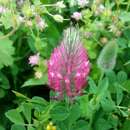Distribution in Egypt
provided by Bibliotheca Alexandrina LifeDesk
Mareotic sector, north Sinai, Mountainous southern Sinai.
- author
- BA Cultnat
- provider
- Bibliotheca Alexandrina
Global Distribution
provided by Bibliotheca Alexandrina LifeDesk
Mediterranean region, west Asia.
- author
- BA Cultnat
- provider
- Bibliotheca Alexandrina
Life Expectancy
provided by Bibliotheca Alexandrina LifeDesk
- author
- BA Cultnat
- provider
- Bibliotheca Alexandrina
Brief Summary
provided by EOL authors
Trifolium purpureum one of the 300 species of the clover genus Trifolium (Fabaceae).It is native to fields, roadsides, and disturbed area in southern Europe from Portugal to Romania, the Crimea to Israel and to North Africa from Egypt to Morocco.The plant has also been recorded in northeast Massachusetts, around wool waste plants, where it evidently was introduced from Europe (Fletcher 1913). In NSW, Australia, T. purpureum has been developed as a pasture species because it produces green feed longer in the spring/summer than do other annuals and is tolerant of a variety of soil type and water logging, and it is grown for silage and hay in Europe as well as Australia.An annual, self-regenerating herbaceous plant, it grows upright, usually between 10 and 50 cm, sometimes up to a meter tall. It has long thin leaflets and a triangular, purple flower up to 8 cm (3 inches) long (Hacker et al. 2006; Wikipedia 2014).
Trifolium purpureum contains glycosides, phenols, Komorinim, flavonoids, and Silitzilitim mineral acids.It is commonly used in Arab folk medicine to treat diarrhea, menstrual irregularities, skin damage, cough, rubella, and for stress, nervousness and insomnia (Wikipedia 2014).
Physical Description
provided by USDA PLANTS text
Annual, Herbs, Taproot present, Nodules present, Stems erect or ascending, Stems less than 1 m tall, Stems solid, Stems or young twigs sparsely to densely hairy, Leaves alternate, Leaves petiolate, Stipules conspicuous, Stipules green, triangulate to lanceolate or foliaceous, Stipules persistent, Stipules clasping stem at the base, Stipules adnate to petiole, Leaves compound, Leaves palmately 2-3 foliate, Leaflets dentate or denticulate, Leaflets 3, Leaves glabrous or nearly so, Inflorescences racemes, Inflorescence terminal, Bracts conspicuously present, Bracteoles present, Flowers zygomorphic, Calyx 5-lobed, Calyx glabrous, Petals separate, Corolla papilionaceous, Pet als clawed, Petals red, Petals blue, lavander to purple, or violet, Banner petal narrow or oblanceolate, Wing petals narrow, oblanceolate to oblong, Wing petals auriculate, Wing tips obtuse or rounded, Keel tips obtuse or rounded, not beaked, Stamens 9-10, Stamens diadelphous, 9 united, 1 free, Filaments glabrous, Style terete, Fruit a legume, Fruit unilocular, Fruit indehiscent, Fruit oblong or ellipsoidal, Fruit orbicular to subglobose, Fruit or valves persistent on stem, Fruit enclosed in calyx, Fruit glabrous or glabrate, Fruit 1-seeded, Fruit 2-seeded, Fruit 3-10 seeded, Seeds cordiform, mit-shaped, notched at one end, Seed surface smooth, Seeds olive, brown, or black.

